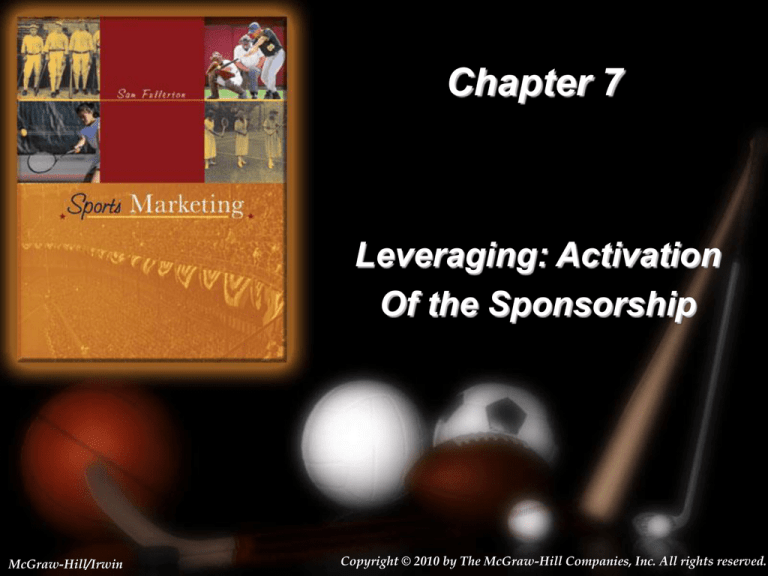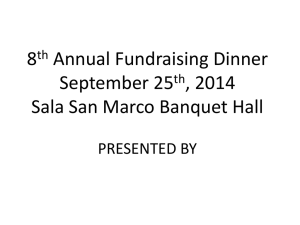
Chapter 7
Leveraging: Activation
Of the Sponsorship
McGraw-Hill/Irwin
Copyright © 2010 by The McGraw-Hill Companies, Inc. All rights reserved.
7-1
Leveraging
• Sponsorship Has Been Characterized as a
License to Spend More Money
• Sponsorship Is Not a Stand-Alone Activity
• Need to Support Any Sponsorship with
Additional Efforts Designed to Reinforce
the Awareness that the Marketer Is an
Official Sponsor of the Property
7-2
Leveraging
• Also Referred to as:
– Activation
– Collateral Support
• Defined as:
– the set of strategic initiatives that are
designed to support and enhance the
sponsorship
7-3
Why Leverage?
• Reinforce Relationship in Consumers’
Minds
• Reduce Vulnerability to Ambush Marketing
• Increase Likelihood that the Sponsorship
Will Achieve Its Anticipated Objectives
7-4
License to Spend
• Drop in Figure 7.1 Here
7-5
How Much Should Be Spent
on Leveraging Activities?
• No Universal Agreement
• Actual Amounts Vary Significantly
• Generally Accepted Standard Is That a
Minimum of $1 Should Be Spent on
Leveraging for Each $1 Committed to
Rights Fees
7-6
Leveraging in Practice
• IEG Reported Expenditure Ratio in 2004:
$1.30 Spent on Leveraging for Each $1.00
Paid in Rights Fees
• New Report Indicates that Ratio Increased
in 2007 to an All-time High of $1.90
7-7
Leveraging Techniques
• Drop in Box 7.1 Here
7-8
Theme-Based Advertising
• Use Advertising that Focuses on the Same
Theme Germane to the Sponsored Event
• For example:
– adidas Sponsors FIFA and the World Cup of
Soccer; They Use TV and Magazine Ads that
Feature a Soccer Theme to Leverage that
Sponsorship
7-9
Example of Theme-Based Ad
• Drop in Figure 7.2 Here
7-10
Advertise During
the Broadcast of the Event
• Often, Sponsors Are Given Opportunities
to Purchase Advertising Time Prior to that
Time Being Offered to Nonsponsors
• For Example:
– McDonald’s Airs TV Advertisements during
the Olympic Broadcast in an Effort to
Leverage Its Sponsorship of the IOC
7-11
Advertise in the Event Program
• Reach the Fans at the Event; Those in
Attendance Will Read the Program and Be
Exposed to the Sponsors’ Advertisements
• For example:
– FedEx Used Ads in the Ryder Cup Program to
Reach Fans and Increase On-Site Business
7-12
Use Sponsee’s Logo
on Packaging & Promotion
• Incorporate Trademarks and Logos of the
Sponsored Event on Product Packaging
• Must Have Been Granted This Right in the
Contract by the Sponsee
• Incorporate Logo on Other Promotional Efforts
• For Example:
– McDonald’s Incorporates Logos of World Cup, UEFA,
& Olympics on Its Drink Cups
7-13
Use of Logo on Packaging
• Drop in Figure 7.3 Here
7-14
Distribution of Free
Products or Premiums
• Use Free Samples of Sponsor’s Product
or Promotional Giveaways that Feature
the Sponsee’s Trademarks and Logos
• For Example:
– Absopure Gives Free Samples of Its Water at
Michigan Stadium
– GM Gave Out Poster Featuring NFL Team
7-15
Use of Premium
• Drop in Figure 7.4 Here
7-16
Provision of Prizes
• Sponsor Provides Goods and Services
that Sponsee Uses as Prizes for Selected
Activities
• For Example:
– Southwest Airlines Provides Tickets that
MLB’s St. Louis Cardinals Give Away to
Contest Winners Selected from Fans in
Attendance
7-17
Point-of-Sale Display (POS)
• Use of Themed Signage at Retailers; the
Signage Features the Sponsorship
• For Example:
– adidas Uses Displays that Feature Soccer in
General and the Brazilian Soccer Team in
Retail Stores in South America
7-18
Push Strategy for Retailers
• Engaging in Activities Designed to Persuade
Retailers to Increase Exposure of the Sponsor’s
Products and Promotions within the Retail Stores
• This May Involve Some Type of Financial
Compensation for the Retailer
• For Example:
– NASCAR’s Sponsor, Country Time, Achieved a
Substantial Increase in Display Space because
Retailers Saw a Chance to Increase Their Sales
7-19
Consumer Sales Overlay
• Consumers Associated with the Sponsor
Can Buy Tickets at Discounted Prices
• For Example:
– AAA Is a Sponsor of the Detroit Tigers;
Members of AAA Have Several Opportunities
Each Season to Purchase Tickets at Half
Price (2 for 1)
7-20
Cross-Promotions
with Co-Sponsors
• Collaborate with Another of the Property’s
Sponsors in a Joint Marketing Endeavor
• For Example:
– U.S. Olympic Team Sponsors (Hilton Hotels
and United Airlines) Put Together Travel
Packages While Referencing Their
Association with the USOC
7-21
Affinity Programs
• Capitalize of the Brand Equity and the
Consumers’ Affection for the Sponsee
• Effective For CRM-Based Sponsorships, but
Applicable in Sports Marketing
• For Example:
– MNBA NFL “Extra Points” Visa Credit Card Features
NFL Logos and Consumer Benefits Are Accumulated
by Using the Card
7-22
Web Tie-Ins
• Acknowledgement of the Relationship on
the Sponsor’s Own Web site – May Link
• For Example:
– McDonald’s Web Site Has a Link for “Sports”
Clicking Through Will Direct the Browser to a
Listing of All of the Marketer’s Sponsorships
Where One Can Click Through to Any of Its
Sponsorships Including the IOC, All American
High School Basketball, FIFA, and NASCAR
• http://www.mcdonalds.com/usa/sports.html
7-23
Provide Hospitality
• Reward Top Employees & Customers
• Reinforce Relationship with Sponsee in
the Eyes of Those Entertained by Sponsor
• For Example:
– Nokia Invited 2,000 Customers to Attend the
Nokia Sugar Bowl – Included Parties and
Other Events Affiliated with the Game
7-24
Overview of Leveraging
• Essential for Maximizing Impact
• Expensive – Consider Cost of Leveraging
as Well as the Cost of the Rights Fees
• Sponsee Can Advise Sponsors on the Use
of Effective Leveraging Strategies
7-25
Example of a Leveraging Effort
• Visa and the NFL
• Components
– Affinity Credit Card
– Contest for Consumers Who Use the Card
– Print Advertising Featuring NFL Logos
– POS Featuring NFL Logos in Stores
– Cross-Promotion with DirecTV
– Chance to Win Tickets to Super Bowl
7-26
Example of a Leveraging Effort
• Best Western International and NASCAR
• Components
– NASCAR Room Rate (Discounts)
– Affinity Credit Card
– Cross-Promotions with Co-Sponsors
– On-Site Hospitality at Race Location
– Access to Tickets through Hotel
7-27
Ten Steps to Effectively
Leveraging a Sponsorship
• Drop in Box 7.2 Here
7-28
Make-Buy Decision
• Make – Sponsor Develops and
Implements Its Own Leveraging Program
• Buy – Sponsor Hires an Outside Agency to
Assist in the Development and
Implementation of Its Leveraging Program
7-29
Who Is Used When “Buying”?
• Insert Figure 7.7 Here
7-30
Closing Capsule
• If a Sponsorship Fails to Achieve Its
Objectives, the Sponsor Must First Ask
Itself: “Did We Do an Adequate Job in
Leveraging Our Sponsorship?”
• Leveraging Helps Reduce Impact of
Ambush Marketing Efforts
7-31
Closing Capsule
• Sponsorship Is Only Effective When the
Consumer Recognizes the Relationship
between the Sponsor and the Sponsee
• Effective Leveraging Makes that
Recognition Far More Likely
7-32





